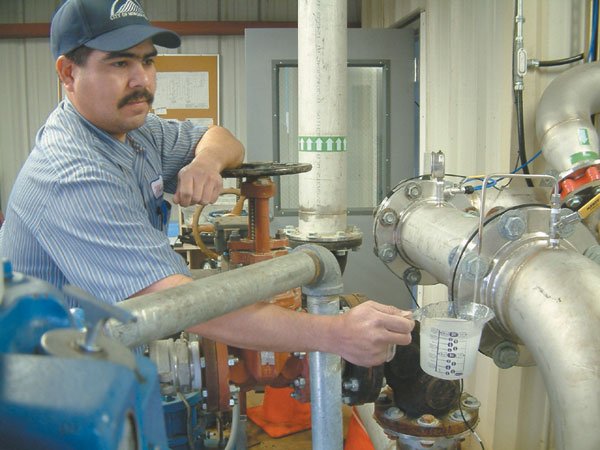Water consumers can look forward to a 5 percent surcharge
reduction starting July 1, if the proposed city budget is passed by
the council in coming weeks.
Water consumers can look forward to a 5 percent surcharge reduction starting July 1, if the proposed city budget is passed by the council in coming weeks.
The move, which would lower the surcharge fee from 15 to 10 percent, would save the median single-family residential user about $1.05 a month.
But city officials would rather not tack on a surcharge at all. They’ve asked the California State Water Resources Control Board to force Olin Corp., the company that leaked perchlorate into the city’s well source for possibly decades, to pay for one well’s treatment and overall more stringent groundwater cleanup.
One of the city petition’s requests SWRCB order Olin to incorporate Tennant Well in its cleanup plans, thereby passing the buck from the city’s ratepayers to Olin. If this happened, the surcharge could be reduced even further, City Manager Ed Tewes said.
In 2000, Olin Corp. officials discovered they had been leaking perchlorate into the groundwater at their Tennant Avenue road-flare production site and reported it to the Central Coast Regional Water Quality Control Board, a regional board that operates under the California State Water Resources Control Board. The regional board ordered Olin to replace the water by building Morgan Hill residents a new well, which is the San Pedro Well at Murphy Avenue. Further cleanup orders to Olin for Morgan Hill, San Martin and Gilroy are ongoing.
The salt can cause thyroid problems and infants and pregnant women are especially susceptible. Olin produced signal flares from 1956 to 1995 on the 13-acre property located at 425 Tennant Ave. in Morgan Hill.
Perchlorate is a common contaminant, found in many drinking water sources across California as well as around the United States. But that doesn’t mean Morgan Hill should put up with it in their water – especially since they know the source, city officials say.
The perchlorate surcharge pays for the city’s legal fees as well as treatment costs and was first tacked onto bills in April 2004 as a 5 percent perchlorate surcharge. It was raised to 10 percent in January 2006, and then to 15 percent in January 2007. The Nordstrom Well’s perchlorate levels are under the state-mandated 6 parts per billion (ppb) so it is no longer treated, saving the city tens of thousands of dollars a year. So the surcharge can be reduced, Tewes said.
By 2011, city officials expect to have spent more than $5 million on perchlorate, largely paid for by the surcharge to water customers, according to projections in the proposed city budget.
The median single family residential user pays about $3.17 toward the surcharge each month, over their usual $21.10 water bill. If the surcharge goes through, the same household will pay about $2.11 toward the surcharge.
Morgan Hill’s petition to the state board centers around the Tennant Well, which the city closed in 2000 and reopened with an ion-exchange filtration system in 2006. The Tennant Well contributes 450 gallons per minute to the city’s production of 219 million gallons annual water use. There are 13 total wells in use in Morgan Hill. The only time that all 13 are pumped all at once is during the summer, when residents can use 13 million gallons of water in a single day, or double the daily average.
The water delivered to city customers is exclusively groundwater pumped from a network of wells around the city, which draw water from the Llagas Subbasin underground aquifer. The city purchases the water from the Santa Clara Valley Water District, which acts as the county’s water wholesaler.
The state board has until late September to respond to the petition.
In the meantime, the petition has generated feedback from Olin and the Central Coast Water Quality Control Board that contains biting criticism of what they call Morgan Hill’s “cavalier” attitude toward the Llagas Subbasin, the perchlorate-contaminated groundwater source.
The regional board contends that Olin is doing enough. It also asserts that because the Tennant Well is so close to the old Olin site where perchlorate is believed to lie dormant, pumping the Tennant Well could pull more perchlorate into the city’s water.
“The water board has alerted the city from the beginning that by pumping the Tennant Well, if the problem is exacerbated, the city could be held liable in the future,” said Hector Hernandez, the regional water board’s Olin site project manager.
Olin’s response has been that Morgan Hill officials don’t understand the complex language of the December 2007 cleanup and abatement order, and that the regional board’s demands have been clear and adequate.
Both request the state water control board deny the petition.
“They’ve essentially said, ‘we know it’s in your drinking water but don’t worry about it,’ ” City Manager Ed Tewes said. “But we do worry about it.”
Hernandez said the regional board orders Olin to install extraction wells to pull perchlorate from the shallow, medium and deep aquifers, which they have done. The extraction wells will become operational by the end of 2009, he said. But Tewes contends that because those wells are only located at the perchlorate plume’s hot spots in San Martin, the cleanup order doesn’t solve Morgan Hill’s perchlorate problems.














